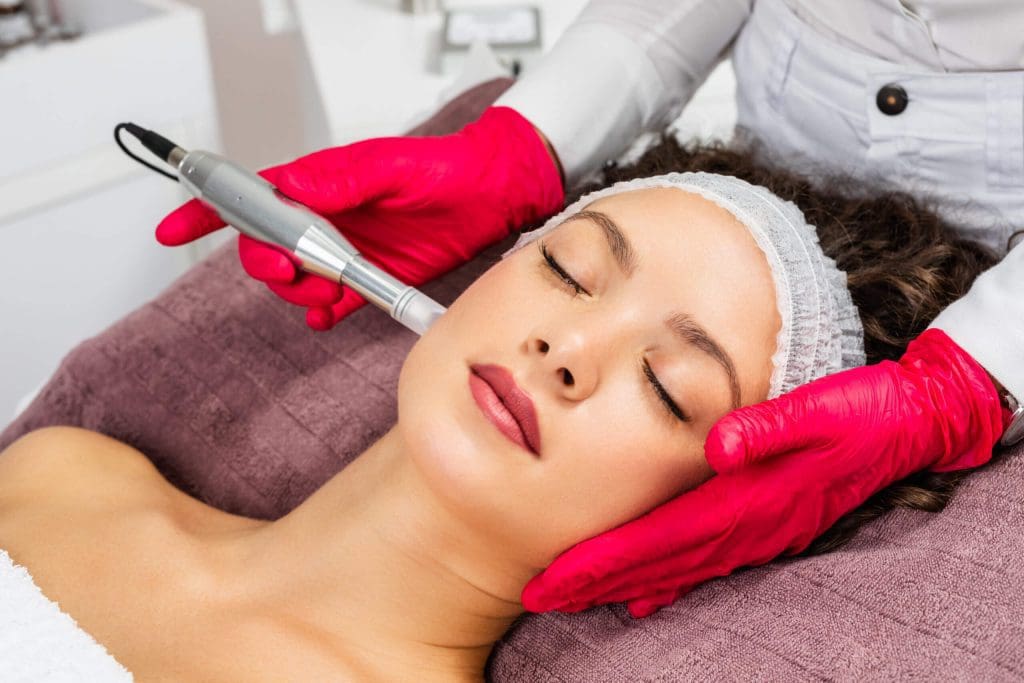In the world of skincare, two treatments often go head-to-head: microneedling vs. chemical peels. Both promise smoother, brighter, and more youthful-looking skin—but they work in very different ways. If you’re unsure which one is right for your unique skin type or concerns, this guide breaks down everything you need to know to make an informed choice.
Understanding the Basics – What Is Microneedling?
Microneedling is a minimally invasive treatment that uses fine needles to create tiny punctures—also called “micro-injuries”—on the skin’s surface. These controlled micro-injuries stimulate the body’s natural wound-healing response, leading to increased collagen and elastin production.
There are two common types of microneedling treatments:
– SkinPen Microneedling – A precise, pen-like device that targets fine lines, acne scars, large pores, and dull texture.
– RF (Radio Frequency) Microneedling – Combines microneedling with radiofrequency energy to deliver heat below the skin’s surface. This enhances skin tightening, collagen synthesis, and deep rejuvenation.
Breaking It Down – What Are Chemical Peels?
Chemical peels are resurfacing treatments that use a blend of acids to exfoliate the skin. Depending on the formulation and strength, a chemical peel can remove the topmost layer or penetrate deeper layers to treat a variety of skin concerns.
One popular option is the Neova Chemical Peel, which uses targeted exfoliants and skin-nourishing ingredients to improve tone, texture, and clarity. It’s particularly effective for:
– Reducing hyperpigmentation
– Treating sun-damaged skin
– Improving mild to moderate acne
– Enhancing overall brightness
Microneedling vs. Chemical Peels – Key Differences
While both treatments rejuvenate the skin, they do so through distinct methods. Here’s a side-by-side comparison of microneedling vs. chemical peels:
| Aspect | Microneedling | Chemical Peels |
| Mechanism | Mechanical (tiny needles create micro-injuries) | Chemical (acids exfoliate the outer skin layers) |
| Downtime | Mild redness for 24–48 hours | Peeling and flaking for 3–7 days, depending on depth |
| Ideal Concerns | Scars, fine lines, large pores, loose skin | Pigmentation, dullness, sun damage, uneven tone |
| Suitability for Skin Tones | Safe for all skin tones | Some deeper peels may not suit darker skin tones |
| Treatment Depth | Controlled needle depth, customizable | Depth depends on acid concentration |
Which Treatment Is Best for Your Skin Type?
Choosing between microneedling vs. chemical peels depends largely on your skin type, specific concerns, and how your skin typically reacts to exfoliation or stimulation.
Oily & Acne-Prone Skin
If you struggle with breakouts, clogged pores, or post-acne scarring, both treatments can help—but in different ways.
– Microneedling is effective in reducing acne scars and minimizing large pores. The SkinPen creates micro-channels that also allow for better absorption of acne-fighting serums.
– Chemical Peels (especially lighter formulations) can help clear clogged pores and reduce oiliness. They also improve skin texture over time.
Best option: Consider microneedling if acne scars are your main concern. For congestion and oil control, a light peel may be more appropriate.
Dry or Sensitive Skin
Sensitive skin requires gentle handling, making this a tricky category.
– Microneedling is generally safe for sensitive or dry skin since it doesn’t involve any harsh chemicals. The treatment may cause mild redness but is less likely to cause irritation.
– Chemical Peels, especially medium or deep ones, maybe too aggressive for reactive skin types.
Best option: Microneedling offers a safer and more controlled option for sensitive or dry complexions.
Hyperpigmentation & Sun Damage
Uneven skin tone and sunspots can be stubborn, but both treatments show promise.
– Microneedling promotes cellular turnover and can reduce the appearance of hyperpigmentation over time, especially when combined with brightening serums.
– Chemical Peels, particularly those containing glycolic or salicylic acid, are direct exfoliators that lighten dark spots and sun-damaged areas more rapidly.
Best option: Chemical peels offer quicker results for hyperpigmentation, but microneedling can enhance and maintain those improvements long-term.
Mature or Aging Skin
If your main concern is aging—fine lines, wrinkles, and skin laxity—you’ll want to focus on collagen stimulation.
– RF Microneedling is particularly effective here. The added radiofrequency energy tightens and firms the skin from within.
– Chemical Peels help by smoothing fine lines and boosting brightness but don’t offer deep tissue firming.
Best option: For anti-aging, RF microneedling is a standout choice. Chemical peels can be used as a maintenance treatment between microneedling sessions.
How to Choose Between Microneedling and Chemical Peels?
When weighing microneedling vs. chemical peels, your best bet is to consider the following:
– Skin Goals – Are you targeting scarring, texture, or pigmentation?
– Skin Sensitivity – Does your skin react easily to exfoliants or acids?
– Downtime Tolerance – Are you okay with some peeling or redness?
– Long-Term Vision – Are you looking for collagen remodeling or surface-level results?
There’s no universal answer, and sometimes, the most effective approach may involve a combination of both treatments spaced appropriately. A skincare professional can help customize the ideal plan for your skin type and goals.
Take the Next Step Toward Radiant Skin at Viva Vitality Med Spa
Understanding your skin type, comfort level, and expectations is the first step. By comparing microneedling vs. chemical peels, you’re already on the right track to making a confident, informed choice for your skin.
Choosing between microneedling and a chemical peel doesn’t have to be overwhelming. Your skin is unique, and with the right guidance, you can discover a treatment plan that truly supports your glow goals. Let your transformation begin with a personalized consultation at Viva Vitality Med Spa—where expert care meets advanced skin solutions tailored just for you.
FAQs
1. Can you combine microneedling and chemical peels in the same skincare routine?
Yes, but not at the same time. These treatments should be spaced out to prevent irritation. A skincare professional can help create a schedule that alternates them safely.
2. Which treatment is more cost-effective in the long run?
Microneedling may require fewer sessions for long-term collagen stimulation, while chemical peels may need more frequent maintenance depending on the strength used.
3. How long should you wait between sessions for each treatment?
Microneedling is typically spaced 4–6 weeks apart. Chemical peels vary based on strength—light peels can be repeated every 2–4 weeks, while deeper ones require more time between treatments.
4. Is either treatment safe during pregnancy or breastfeeding?
Most professionals recommend avoiding microneedling and chemical peels during pregnancy and breastfeeding due to potential sensitivities and lack of safety studies.
5. Will either treatment make my skin more sensitive to the sun?
Yes. Both treatments temporarily increase photosensitivity. Sunscreen and post-treatment care are essential to protect your results and prevent damage.


